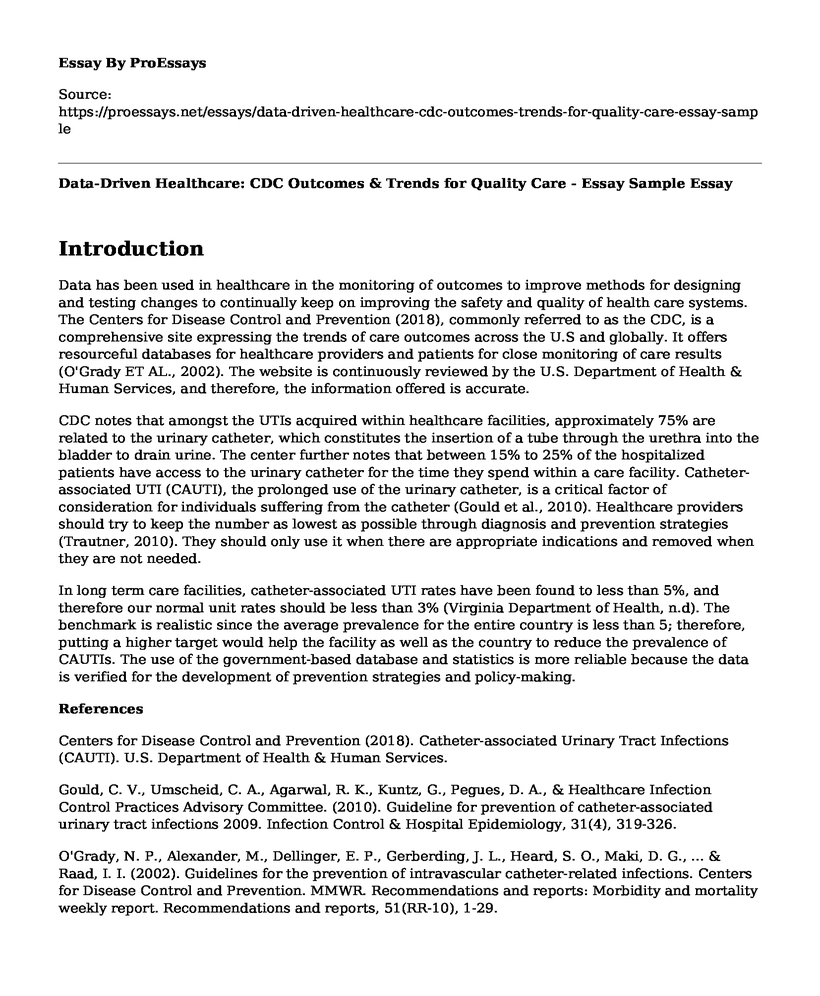Introduction
Data has been used in healthcare in the monitoring of outcomes to improve methods for designing and testing changes to continually keep on improving the safety and quality of health care systems. The Centers for Disease Control and Prevention (2018), commonly referred to as the CDC, is a comprehensive site expressing the trends of care outcomes across the U.S and globally. It offers resourceful databases for healthcare providers and patients for close monitoring of care results (O'Grady ET AL., 2002). The website is continuously reviewed by the U.S. Department of Health & Human Services, and therefore, the information offered is accurate.
CDC notes that amongst the UTIs acquired within healthcare facilities, approximately 75% are related to the urinary catheter, which constitutes the insertion of a tube through the urethra into the bladder to drain urine. The center further notes that between 15% to 25% of the hospitalized patients have access to the urinary catheter for the time they spend within a care facility. Catheter-associated UTI (CAUTI), the prolonged use of the urinary catheter, is a critical factor of consideration for individuals suffering from the catheter (Gould et al., 2010). Healthcare providers should try to keep the number as lowest as possible through diagnosis and prevention strategies (Trautner, 2010). They should only use it when there are appropriate indications and removed when they are not needed.
In long term care facilities, catheter-associated UTI rates have been found to less than 5%, and therefore our normal unit rates should be less than 3% (Virginia Department of Health, n.d). The benchmark is realistic since the average prevalence for the entire country is less than 5; therefore, putting a higher target would help the facility as well as the country to reduce the prevalence of CAUTIs. The use of the government-based database and statistics is more reliable because the data is verified for the development of prevention strategies and policy-making.
References
Centers for Disease Control and Prevention (2018). Catheter-associated Urinary Tract Infections (CAUTI). U.S. Department of Health & Human Services.
Gould, C. V., Umscheid, C. A., Agarwal, R. K., Kuntz, G., Pegues, D. A., & Healthcare Infection Control Practices Advisory Committee. (2010). Guideline for prevention of catheter-associated urinary tract infections 2009. Infection Control & Hospital Epidemiology, 31(4), 319-326.
O'Grady, N. P., Alexander, M., Dellinger, E. P., Gerberding, J. L., Heard, S. O., Maki, D. G., ... & Raad, I. I. (2002). Guidelines for the prevention of intravascular catheter-related infections. Centers for Disease Control and Prevention. MMWR. Recommendations and reports: Morbidity and mortality weekly report. Recommendations and reports, 51(RR-10), 1-29.
Trautner, B. W. (2010). Management of catheter-associated urinary tract infection (CAUTI). Current opinion in infectious diseases, 23(1), 76.
Virginia Department of Health (n.d). Urinary Tract Infections and Catheter-Associated Urinary Tract Infections. Retrieved from http://www.vdh.virginia.gov/surveillance-and-investigation/hai/organisms/uti-and-cauti/
Cite this page
Data-Driven Healthcare: CDC Outcomes & Trends for Quality Care - Essay Sample. (2023, Apr 04). Retrieved from https://proessays.net/essays/data-driven-healthcare-cdc-outcomes-trends-for-quality-care-essay-sample
If you are the original author of this essay and no longer wish to have it published on the ProEssays website, please click below to request its removal:
- Medicine Literature Review: History and Background of Salmonella
- Risk Communication in Time of Radiation Disaster Essay
- Children of Divorce Are Delayed in Many Aspects: Research Paper
- How Best Can We Handle the Opioid Crisis?
- Evaluation Essay on Google: Sustainable Competitive Advantages
- Research Paper on Regulating Nurses & Midwives
- Paper Example on COVID-19: Examining Attitudes & Behaviour During a Pandemic







